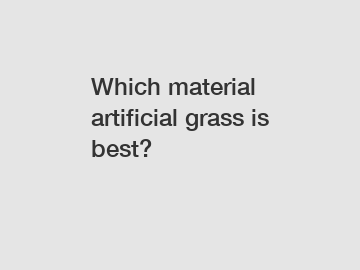Which material artificial grass is best?
Which material artificial grass is best?
Artificial grass has become increasingly popular over the years, offering homeowners and businesses a low-maintenance alternative to natural grass. However, with the wide range of materials available, it can be difficult to determine which one is the best. In this article, we will discuss the various materials commonly used in the manufacturing of artificial grass and evaluate their pros and cons to help you make an informed decision.
1. Polyethylene:

Polyethylene is the most common material used in the production of artificial grass. It is known for its soft texture, making it comfortable to walk or play on. This material also provides excellent resilience, allowing the grass to quickly bounce back after being compressed. Additionally, polyethylene blades have exceptional UV stability, ensuring that they won't fade under the sun's harsh rays. However, it is worth noting that polyethylene can heat up quickly, especially in high temperatures, which may make it uncomfortable to walk on.
2. Polypropylene:
Polypropylene is another popular material used in artificial grass. It is less expensive than polyethylene, which makes it an attractive option for those on a budget. Although polypropylene may not have the same level of softness as polyethylene, it is still durable and suitable for low-traffic areas or decorative purposes. However, it is not as resilient as polyethylene and can flatten over time under heavy use. Moreover, it has poor resistance to UV rays, so its color may fade more quickly compared to other materials.
3. Nylon:
Nylon is a strong and resilient material commonly used in high-traffic areas such as sports fields. It can withstand heavy use without losing its shape or texture. Additionally, nylon has excellent resistance to UV rays, ensuring that the color of your artificial grass remains vibrant for a longer period. Nevertheless, nylon tends to be more expensive than other materials, making it less accessible for residential applications. Its stiff texture may also be less comfortable for bare feet.
4. Blends:
Many manufacturers create artificial grass using a combination of materials to optimize their performance. For example, a popular blend is polyethylene with polypropylene that combines the softness and UV resistance of polyethylene with the cost-effectiveness of polypropylene. Such blends aim to provide the best balance between durability, appearance, and affordability. If you are looking for a specific set of features, exploring different blends might be a wise choice.
In conclusion, determining the best material for artificial grass depends on your unique preferences and needs. If comfort and UV resistance are your priorities and you are willing to invest, polyethylene may be the best option for you. For those on a budget or looking for decorative purposes, polypropylene could be a suitable choice. Nylon is ideal for high-traffic areas but may be cost-prohibitive for residential applications. Lastly, blends provide a compromise between various factors, allowing you to find the right combination for your specific requirements. With this information in mind, you can confidently choose the material that best suits your artificial grass needs and enjoy the benefits it brings without the hassle of natural grass maintenance.
If you want to learn more, please visit our website SBR latex for paper, Carboxy nitrile rubber latex, artificial grass backing.

Comments
0